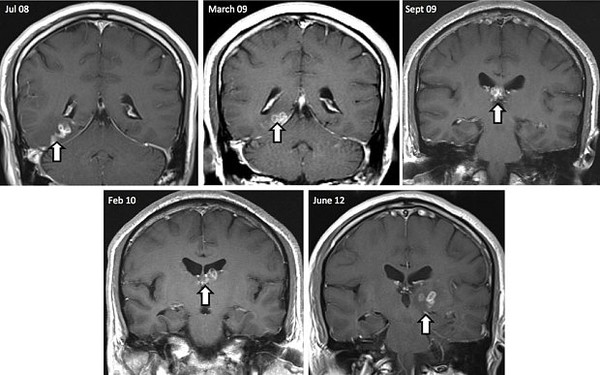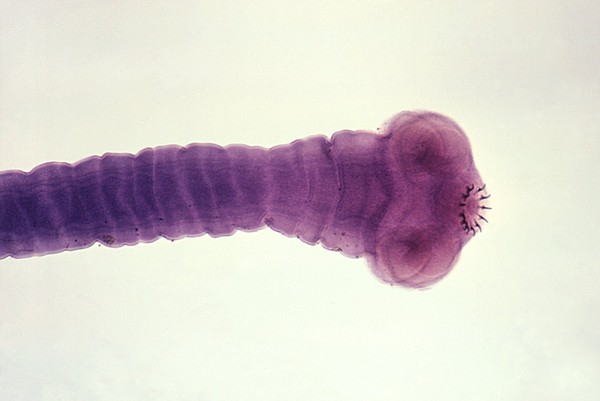Parasites like to nest and eat human brains
These parasites are extremely harmful when they can nest on the brain and cause death.
Close up of 4 parasites like to nest and eat human brains
We know that parasites are microscopic organisms that often live on parasites on the host to suck nutrients or suck blood from the host to live.
There are parasites that inhabit our limbs, intestines, eyes, but not many parasitic species prefer to nest in the human brain . Which parasites are they and how dangerous are they? The following article will help you get the answer.
1. Flukes Spirometra
In 2012, an English man who was diagnosed by a doctor carried an individual Spirometr tapeworm in his brain.
Earlier in 2008, the man came to the hospital for examination due to a headache, convulsions, poor memory and changes in the sense of smell, but the doctor could not determine the cause of the disease.

The scanned image shows the movement of the fluke in the patient's head over time (arrow).
Four years later, the doctors were surprised to find that between brain tissue is a creature up to 10cm long. This parasite was found through MRI imaging. Because there is no effective treatment, doctors quickly undergo surgery to remove this organism.
According to experts, this species is quite rare, its life cycle and biological characteristics are still unknown. However, scientists believe it can be transmitted through eating small crustaceans or meat of reptile and amphibian species.

The adult form of tapeworm Spirometra occurs only in the small intestine of cats and dogs, but they are released and exist in feces, living in water sources.
Larvae may remain in small or frog and snake crustaceans. At this stage, they enter the human body through the gastrointestinal tract or in direct contact with the infected animals.
Larvae form follicles inside the brain or other organs, resulting in tissue damage, blindness, paralysis and even death.
2. Pig tapeworm
Tapeworms are divided into many different genera and types, of which 3 are more likely to 'invade' your brain. The pig tapeworm is thought to be the brain's biggest enemy.

The scientific name is Taenia Solium , the tapeworm pig can reach the human body by two ways: eating undercooked pork thereby causing tapeworm disease in the intestine or following direct contact with the feces of fish pig infected.
According to the second pathway, this fluke will enter the human body in the form of larvae and can follow the blood sugar up to the nervous system and the brain then bases it here. They can cause epilepsy and other dangerous neurological disorders .

Pig tapeworm is a common fluke throughout the United States, Africa and Asia. Poor quality hygiene is the leading cause of pig tapeworm infections.
3. Sterilize amoeba to eat brain
With the scientific name Naegleria fowleri , this is a single-celled amoeba living freely outside the environment. Although rare, it can cause an infection and damage our brain once it gets into the body.

This type of amoeba is often found in warm freshwater areas such as in lakes, rivers and hot springs as well as in soil. Naegleria fowleri often enters the human body through the nasal passages and gradually moves to the brain.
Symptoms of this attack are to cause the patient to have symptoms of headache, stiff neck and vomiting . More severe than the victim will fall into a coma and die after about five days.

The process of infection usually occurs when we swim or dive in warm freshwater areas like lakes and rivers. From 1962, only two cases of patients survived after being infected by this type of amoeba.
4. Toxoplasma gondii
Sheiphali "Toxoplasma" gondii is a protozoa belonging to the genus Toxoplasma , often found in parasites in cats.

They are considered masters because once the rat is infected by Toxoplasma gondii, it will be controlled - leading the body to be the bait for the cat. And when entering the human body, this parasite also tries to acquire our brain.

While up to 60% of the total population infected with Toxoplasma gondii, only a few actually suffer from this parasite-related disease.
Studies have shown that this parasite can affect human behavior and cause many types of mental disorders such as depression, anxiety, schizophrenia .

Men infected with HIV have the ability to own low IQ, unable to concentrate long. They also often break laws, accept risks, are unfriendly, suspicious, jealous or sadder.
Meanwhile infected women are usually more outward, friendly and considered more attractive.
- Horror parasites on the human body
- 4 types of parasites that are extremely dangerous to eat meat
- Cigarettes help birds chase after parasites
- How to use bird's nest is healthy
- Air nest dryer helps farmers save hundreds of millions of dong / year
- Score 4 'monsters' in your body
- The frightening appearance of the parasite on human face
- How to recognize real bird's nest water
- The nest nest knows how to plant fruit trees to make a nest
- What happens if all the parasites on Earth disappear?
- 100 brains disappear mysteriously
- Successfully developed miniature human brains in the laboratory
 Is the magnetic North Pole shift dangerous to humanity?
Is the magnetic North Pole shift dangerous to humanity? Washington legalizes the recycling of human bodies into fertilizer
Washington legalizes the recycling of human bodies into fertilizer Lightning stone - the mysterious guest
Lightning stone - the mysterious guest Stunned by the mysterious sunset, strange appearance
Stunned by the mysterious sunset, strange appearance